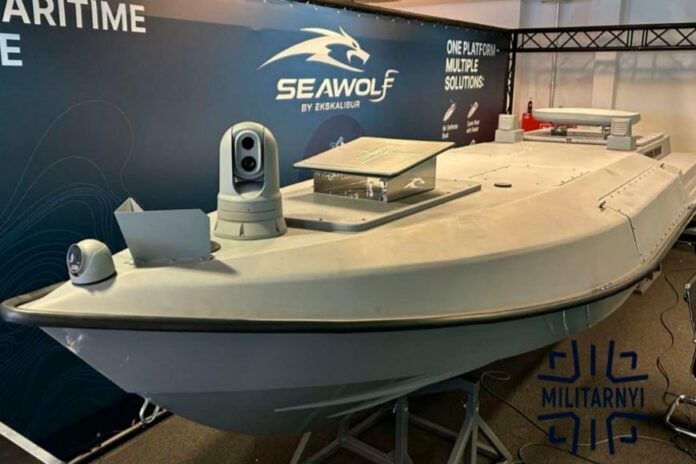According to a Militarnyi’s correspondent, the Seawolf incorporates solutions drawn from Ukraine’s real-world experience in modern naval warfare, offering proven effectiveness and reliable performance.
The company Ekskalibur, which manufactures this versatile platform, stated that it can be quickly configured for various combat or surveillance missions without altering its core components.
Key technical specifications of the Seawolf in its basic version:
- Length: 7.5 m
- Width: 2.2 m
- Height (hull): 0.52 m
- Engine: 270-horsepower diesel
- Range: 1600+ km
- Payload capacity: up to 1650 kg
- Combat load: up to 450 kg
- Fuel capacity: 1400 liters
- Weight (approx.): 950 kg
This surface platform can serve as the basis for various types of drones, including:
- Seawolf R – an air defense boat
- Seawolf MG – a support boat
- Seawolf MGR – a support boat equipped with radar
- Seawolf EW – an electronic warfare boat
- Seawolf M – a minelayer
- Seawolf D – a transport drone
There is also an enlarged 9.5-meter version of the Seawolf, which can be simultaneously equipped with four AIM-9 air defense missiles, a module with an M2 12.7mm machine gun, FPV drones, or a launcher for guided munitions.
It has a payload capacity of 4,000 kg and a range of 1,500 km. According to the developer, this surface drone is suitable for border protection, surveillance, and combined tactical missions.
The Seawolf is designed for asymmetric naval warfare, outperforming traditional vessels in terms of mobility, cost-efficiency, and low detectability.
“Seawolf is a versatile unmanned surface platform engineered to deliver maximum adaptability in modern naval operations,” the developers stated. “Its modular hull design enables seamless integration of a wide range of mission-specific payloads, while maintaining core structural and technical components, streamlining both deployment time and operational costs.”
The platform’s specially designed deck allows for the secure installation of primary and auxiliary systems tailored to customer requirements.
“Meanwhile, key structural and technical elements, including the hull, engine, propulsion system, communications suite, optical sensors, and control system, remain unchanged. This standardized architecture significantly reduces adaptation time and minimizes lifecycle and maintenance costs for the end user,” the developers noted.
Source: Militarnyi



